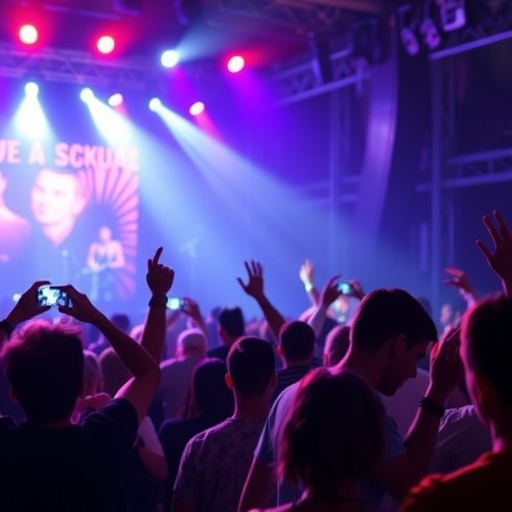A groundbreaking observational study published in the renowned journal Injury Prevention reveals alarming statistics regarding the prevalence of sexual harassment and assault at live music events in the United States. The research, part of the GrooveSafe Fan Experience Survey conducted in 2024, uncovers that an overwhelming six out of ten music attendees report experiencing inappropriate sexual behavior during such gatherings. These figures expose a deeply rooted and troubling culture within live music venues that urgently demands attention and intervention from industry stakeholders, public health officials, and policymakers.
The research meticulously gathered data from 1,091 adults who had attended at least one live music gig in the year prior to the survey. Respondents, representing a balanced demographic with just over half identifying as women, provided detailed accounts of their encounters with a spectrum of inappropriate sexual behaviors. This ranged from unsolicited comments and jokes to more severe acts of non-consensual sex. The granular methodology also involved questioning the respondents about the context of these incidents, including who they were with, and the venue type—whether a small club, large arena, theater, or festival—offering an inclusive perspective on the environments in which these behaviors proliferate.
Notably, the study delineates stark gender disparities in the reported prevalence of sexual misconduct. Women were more than twice as likely to be victims, with 82% acknowledging experiences of sexual harassment or assault, compared to 39% of men. Furthermore, approximately 20% of the women indicated these incidents occurred frequently. The data confirmed that large-scale venues such as arenas and situations where women attended events with friends or intimate partners correlated significantly with higher rates of reported harassment, suggesting specific social and spatial dynamics conducive to victimization.
One of the most disturbing revelations is the exceedingly low rate of incident reporting to venue staff or security personnel. An astonishing 88% of victims did not report their experiences at the time, hinting at systemic barriers within the event spaces designed to protect patrons. When asked why they refrained from reporting, respondents cited numerous obstacles, including uncertainty about who to approach, personal discomfort often exacerbated by intoxication, difficulties in locating assistance, skepticism about being believed, and fear related to the perpetrator’s social or celebrity status. Among these, the belief that “nothing would be done” was the most frequently endorsed barrier, undermining confidence in the effectiveness of existing reporting mechanisms.
From a behavioral psychology standpoint, the study underscores how the confluence of social norms, inadequate venue policies, and the physical environment of live music events creates a fertile ground for antisocial behavior such as sexual harassment. The limited surveillance and lack of proactive regulatory measures facilitate perpetrators’ impunity, while victims face considerable psychological and social hurdles to seek recourse. These dynamics not only affect individual well-being but carry broader implications for public health and socio-cultural equity.
The ramifications of such persistent exposure to sexual misconduct at entertainment venues are multifaceted. Short-term consequences for victims include emotional distress, anxiety, and fear, which can translate to decreased attendance at music events and diminished social participation. Long-term effects extend to chronic psychological trauma and compromised quality of life. The societal burden encompasses not only these personal health concerns but also economic costs linked to healthcare, legal processes, and lost productivity, highlighting this issue as a critical public health challenge.
Despite the depth of the findings, the authors acknowledge inherent limitations in the research. The voluntary nature of survey participation may have introduced selection bias—those with prior victimization experiences might be more motivated to complete such surveys. Additionally, the survey instrument did not capture certain forms of inappropriate sexual conduct, such as upskirting, unauthorized photography, and flashing, which could mean the actual prevalence rates are higher than reported. These constraints point to the necessity for further research with more comprehensive methodologies.
The study’s multifaceted approach to understanding both prevalence and reporting behaviors pioneers a foundation for actionable recommendations. Researchers advocate for music venues to critically assess and enhance their policies, training, and incident response protocols. Effective prevention strategies might include staff education on recognizing and managing sexual harassment, improved visibility and accessibility of reporting options, and collaborative efforts with security professionals to create safer physical environments. Enhanced communication campaigns aimed at empowering patrons to report incidents without fear of dismissal or retribution are equally vital.
Moreover, this research signals an urgent call for interdisciplinary collaboration involving public health experts, sociologists, entertainment industry leaders, and legal authorities. Developing standardized frameworks for surveillance and regulation across diverse venue types could streamline efforts to mitigate sexual misconduct. Parallel investigations into the cultural factors underpinning antisocial behaviors in live music settings may offer insights into targeted interventions that address underlying societal attitudes and norms.
Ultimately, this investigation contributes a crucial empirical voice to an often under-examined issue within the live music industry. By illuminating the scale and complexity of sexual harassment and assault at these events, the study lays essential groundwork for meaningful change. The integration of robust prevention and response mechanisms stands to not only protect attendees but to uphold the integrity and enjoyment of live music experiences for all participants moving forward.
The Injury Prevention journal publication epitomizes the expanding role of observational research in uncovering the nuanced realities of public environments. As the music industry grapples with these revelations, there is hope that increased awareness will galvanize transformative efforts, fostering concert spaces that are equitable, safe, and welcoming for every fan regardless of gender or background.
Subject of Research: People
Article Title: Prevalence and reporting of sexual harassment and sexual assault at live music events in the USA
News Publication Date: 22-Sep-2025
Web References:
10.1136/ip-2025-045809
Keywords: Sexual harassment, Antisocial behavior, Social interaction




